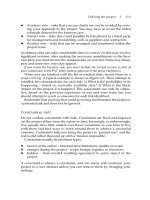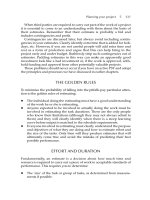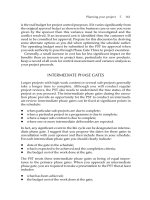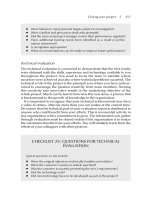Management a practical introduction 3rd kinicky chapter 16
Bạn đang xem bản rút gọn của tài liệu. Xem và tải ngay bản đầy đủ của tài liệu tại đây (471.09 KB, 33 trang )
Management
A Practical Introduction
Third Edition
Angelo Kinicki &
Brian K. Williams
Kinicki/Williams, Management: A Practical Introduction 3e ©2008, McGraw-Hill/Irwin
Chapter 16: Control
Techniques for Enhancing
Organizational Effectiveness
Managing for Productivity
Control
The Balanced Scorecard, Strategy Maps, & Measurement
Management
Levels & Areas of Control
Some Financial Tools for Control
Total Quality Management
Managing Control
Kinicki/Williams, Management: A Practical Introduction 3e ©2008, McGraw-Hill/Irwin
2
16.1 Managing for Productivity
WHAT IS PRODUCTIVITY?
Productivity is defined as outputs divided by inputs
where: outputs are the goods and services produced,
and inputs are labor, capital, materials, and energy
Productivity is important because it determines
whether a company will make a profit and affects a
country’s standard of living
Maintaining productivity depends on control
Kinicki/Williams, Management: A Practical Introduction 3e ©2008, McGraw-Hill/Irwin
3
16.1 Managing for Productivity
Figure 16.1: Managing for Productivity and Results
Kinicki/Williams, Management: A Practical Introduction 3e ©2008, McGraw-Hill/Irwin
4
16.2 Control: When Managers
Monitor Performance
WHY IS CONTROL IMPORTANT?
Control is making something happen the way it was planned
to happen, while controlling is monitoring performance,
comparing it with goals, and taking corrective action as
needed
Recall that:
-planning is setting goals and deciding how to achieve them
-organizing is arranging tasks, people, and other resources
to accomplish the work
-leading is motivating people to work hard to achieve the
organization’s goals
-controlling is making sure performance meets objectives
Kinicki/Williams, Management: A Practical Introduction 3e ©2008, McGraw-Hill/Irwin
5
16.2 Control: When Managers
Monitor Performance
Figure 16.2: Controlling for Productivity
Kinicki/Williams, Management: A Practical Introduction 3e ©2008, McGraw-Hill/Irwin
6
Chapter 16: Control
CLASSROOM PERFORMANCE SYSTEM
The four management functions include all of the
following except
A) implementing
B) organizing
C) planning
D) controlling
Kinicki/Williams, Management: A Practical Introduction 3e ©2008, McGraw-Hill/Irwin
7
16.2 Control: When Managers
Monitor Performance
There are six reasons why control is needed:
1. To adapt to change & uncertainty - organizations
need to be able to deal with change and uncertainty
in the environment
2. To discover irregularities and errors - without
checks and balances, companies might not survive
3. To reduce costs, increase productivity, or add
value - control systems can reduce costs, increase
output, and add value to a product
Kinicki/Williams, Management: A Practical Introduction 3e ©2008, McGraw-Hill/Irwin
8
16.2 Control: When Managers
Monitor Performance
4. To detect opportunities - controls can help firms
identify opportunities that might otherwise go
unnoticed
5. To deal with complexity - controls help firms deal
with the complexities of multiple product lines,
customer bases, and so on
6. To decentralize decision making & facilitate
teamwork - controls allow top managers to
decentralize control to lower levels and encourage
teamwork
Kinicki/Williams, Management: A Practical Introduction 3e ©2008, McGraw-Hill/Irwin
9
16.2 Control: When Managers
Monitor Performance
There are four steps in the control process:
1. Establish Standards
The desired performance level for a given goal is a
control standard, or performance standard
Standards can be broad or narrow
2. Measure Performance
Performance is measured using three sources:
written reports, oral reports, and personal
observation
Kinicki/Williams, Management: A Practical Introduction 3e ©2008, McGraw-Hill/Irwin
10
16.2 Control: When Managers
Monitor Performance
3. Compare Performance To Standards
Measured performance is compared to established
standards
The amount of deviation acceptable depends on the
predetermined range of variation
Some firms follow management by exception where
managers are informed of a situation only if data show a
significant deviation from standards
4. Take Corrective Action, If Necessary
Firms can make no changes to the current situation,
recognize and reinforce positive performance, or take action
to correct negative performance
Kinicki/Williams, Management: A Practical Introduction 3e ©2008, McGraw-Hill/Irwin
11
16.2 Control: When Managers
Monitor Performance
Figure 16.4: Steps in the Control Process
Kinicki/Williams, Management: A Practical Introduction 3e ©2008, McGraw-Hill/Irwin
12
16.3 The Balanced Scorecard, Strategy
Maps & Measurement Management
HOW CAN MANAGERS ESTABLISH STANDARDS
AND MEASURE PERFORMANCE?
The balanced scorecard, strategy maps, and
measurement management are all techniques that
managers use to establish standards and measure
performance
The balanced scorecard gives top management a
fast but comprehensive view of the organization
using four indicators: customer satisfaction, internal
processes, innovation and improvement activities,
and financial measures
Kinicki/Williams, Management: A Practical Introduction 3e ©2008, McGraw-Hill/Irwin
13
16.3 The Balanced Scorecard, Strategy
Maps & Measurement Management
Figure 16.5:
The
Balanced
Scorecard
Kinicki/Williams, Management: A Practical Introduction 3e ©2008, McGraw-Hill/Irwin
14
Chapter 16: Control
CLASSROOM PERFORMANCE SYSTEM
The balanced score card sets goals and performance
measures from all of the following perspectives
except
A) innovation and learning
B) financial
C) customer
D) productivity
Kinicki/Williams, Management: A Practical Introduction 3e ©2008, McGraw-Hill/Irwin
15
16.3 The Balanced Scorecard, Strategy
Maps & Measurement Management
A strategy map is a visual representation of the
four perspectives of the balanced scorecard that
enables managers to communicate their goals so
that everyone in the company can understand how
their jobs are linked to the overall objectives of the
organization
There are two types of organizations:
-measurement-managed companies are ones that
have set measurable criteria that are linked to
performance goals
-non-measurement managed firms do not have
measurable criteria linked to goals
Kinicki/Williams, Management: A Practical Introduction 3e ©2008, McGraw-Hill/Irwin
16
16.3 The Balanced Scorecard, Strategy
Maps & Measurement Management
Figure 16.6: The Strategy Map
Kinicki/Williams, Management: A Practical Introduction 3e ©2008, McGraw-Hill/Irwin
17
16.4 Levels & Areas of Control
HOW SHOULD CONTROL BE IMPLEMENTED?
There are three levels of control:
1. Strategic control is monitoring performance to
ensure that strategic plans are being implemented
and taking corrective action as needed
Strategic control is performed by top managers
with reports being issued quarterly, semi-annually, or
annually
Kinicki/Williams, Management: A Practical Introduction 3e ©2008, McGraw-Hill/Irwin
18
16.4 Levels & Areas of Control
2. Tactical control is monitoring performance to
ensure that tactical plans – those at the divisional or
departmental level – are being implemented and
taking corrective action as needed
Control is done by middle managers with reports
on a weekly or monthly basis
3. Operational control is monitoring performance to
ensure that operational plans – day-to-day goals –
are being implemented and taking corrective action
as needed
Control is by first-line managers with reports on a
daily basis
Kinicki/Williams, Management: A Practical Introduction 3e ©2008, McGraw-Hill/Irwin
19
Chapter 16: Control
CLASSROOM PERFORMANCE SYSTEM
Which type of control issues reports on a weekly or
monthly basis?
A) strategic
B) operational
C) supervisory
D) tactical
Kinicki/Williams, Management: A Practical Introduction 3e ©2008, McGraw-Hill/Irwin
20
16.4 Levels & Areas of Control
There are six areas of organizational control:
1. Physical area control includes things like
equipment controls to monitor computer use,
inventory management controls to keep track of
inventory levels, and quality controls to ensure that
products are being produced properly
2. Controls to monitor human resources include
personality tests, drug tests, and performance tests
3. Controls of informational areas include production
schedules, sales forecasts, and analyses of the
competition
Kinicki/Williams, Management: A Practical Introduction 3e ©2008, McGraw-Hill/Irwin
21
16.4 Levels & Areas of Control
4. Financial controls affect debt payments, payroll,
budgets, and so on
5. Structural control involves the organizational
hierarchy
Bureaucratic control is characterized by rules,
regulations, and formal authority
Decentralized control is characterized by informal
and organic structural arrangements
6. Cultural controls influence the norms and values of
the organization’s culture which then affect the work
process and performance levels
Kinicki/Williams, Management: A Practical Introduction 3e ©2008, McGraw-Hill/Irwin
22
16.3 Some Financial Tools For Control
WHAT ARE THE MAJOR FINANCIAL TOOLS FOR
MANAGERS?
Financial controls including budgets and financial
statements are especially important to firms
A budget is a formal financial projection
Budgets provide a yardstick against which
performance can be measured and comparisons can
be made to other time periods, departments, and so
on
Kinicki/Williams, Management: A Practical Introduction 3e ©2008, McGraw-Hill/Irwin
23
16.3 Some Financial Tools For Control
There are two different ways to budget:
Incremental budgeting allocates increased or decreased
funds to a department by using the last budget as a reference
point—only incremental changes in the budget request are
reviewed
Zero-based budgeting forces each department to start from
zero in projecting its funding needs for the budget period
There two different types of budgets:
Fixed budgets allocate resources on the basis of a single
estimate of costs
Variable budgets allow the allocation of resources to vary in
proportion with various levels of activity
Kinicki/Williams, Management: A Practical Introduction 3e ©2008, McGraw-Hill/Irwin
24
16.3 Some Financial Tools For Control
A summary of some aspect of an organization’s financial
status is a financial statement
There are two basic types of financial statements:
A balance sheet summarizes an organization’s overall
financial worth (assets and liabilities) at a specific point in time
where:
-assets are the resources the organization controls, current
assets are cash and other assets that are readily convertible
to cash fixed assets are property, buildings, and equipment
that are harder to convert to cash, and liabilities are claims by
suppliers, lenders, and others
Kinicki/Williams, Management: A Practical Introduction 3e ©2008, McGraw-Hill/Irwin
25









